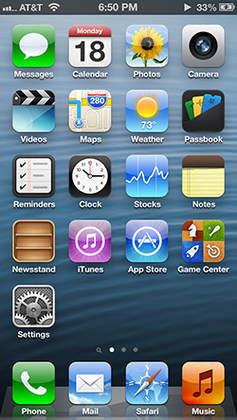
Back IOS 6 ANG آي أو إس 6 Arabic IPhone OS 6 Catalan IOS 6 Danish IOS 6 German IOS 6 Greek IOS 6 Spanish IOS 6 ET آیاواس ۶ FA IOS 6 French
| Version of the iOS operating system | |
 iOS 6 running on the iPhone 5, the last iPhone to support iOS 6 and 5 rows of apps due to the taller screen on the iPhone 5 | |
| Developer | Apple Inc. |
|---|---|
| Source model | Closed, with open source components |
| Initial release | September 19, 2012 |
| Latest release | 6.1.6 (10B500) / February 21, 2014 |
| Update method | Software Update |
| Package manager | App Store |
| Platforms | |
| Kernel type | Hybrid (XNU) |
| Default user interface | Springboard |
| License | Proprietary EULA except for open-source components |
| Preceded by | iOS 5 |
| Succeeded by | iOS 7 |
| Official website | Apple - iOS 6 at the Wayback Machine (archived September 4, 2013) |
| Tagline | It takes your iPhone, iPad, and iPod touch in entirely new directions. |
| Support status | |
| Obsolete, unsupported. Drops support for the iPod Touch (3rd generation), and iPad (1st generation). | |
iOS 6 is the sixth major release of the iOS mobile operating system developed by Apple Inc, being the successor to iOS 5. It was announced at the company's Worldwide Developers Conference on June 11, 2012, and was released on September 19, 2012. It was succeeded by iOS 7 on September 18, 2013.[1]
iOS 6 introduced a new Apple Maps app, which replaced Google Maps as the default mapping service for the operating system; a dedicated Podcasts app, as a central location for podcasts; and a Passbook app, for managing different types of tickets, boarding passes, coupons, and loyalty cards. The App Store received a visual overhaul, featuring a card-based app layout and improved search algorithms. Facebook integration was added to the operating system, allowing status messages, like buttons, and contact and event synchronization with several of Apple's apps. New privacy controls gave users more fine-grained app permissions, as well as an option to prevent targeted advertising. Siri was expanded to more devices and updated with more functionality, such as the ability to make restaurant reservations, launch apps, retrieve movie reviews and sports statistics, and read items from the Notification Center. iOS 6 also added LTE support for more carriers, the ability to purchase movie tickets through Fandango with Siri (USA only), a new button to reset the Advertising Identifier, and improvements to Maps in Japan. Additionally, iOS 6 improved the Photos and Camera apps, allowing users to share photos with iCloud Photo Stream, add filters to their camera shots, and take panoramic photos. The Phone app also received some enhancements, such as the option to reply with a message or set a callback reminder when declining a call, and the ability to enable a Do Not Disturb mode.
iOS 6 received positive reviews. Critics noted that the operating system did not offer any significant speed improvements or major redesigns, but instead focused on refinements, with a general consensus that Apple "isn't overhauling things for the sake of it." iOS 6 did not "completely change the way you use your device," but "each of the tweaks will make many daily smartphone actions easier across the board," and critics praised the refinement of "something that already works extremely well" as "something other companies would do well to emulate."
The release of Apple Maps, however, drew significant criticism, due to inaccurate or incomplete data. The issues prompted an open letter of apology from Apple CEO Tim Cook. Scott Forstall, who had overseen iOS development since its inception, announced his departure from the company shortly after the release of iOS 6.
iOS 6 is the last version of iOS that supports the iPhone 3GS and the fourth-generation iPod Touch. iOS 6 is also the last iOS with the skeuomorphic design.
- ^ Souppouris, Aaron (September 10, 2013). "iOS 7 will come to iPhones and iPads on September 18th". The Verge. Vox Media. Archived from the original on August 27, 2017. Retrieved December 30, 2016.